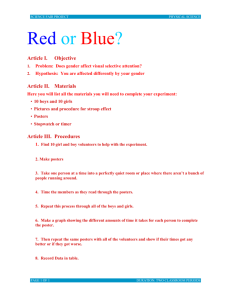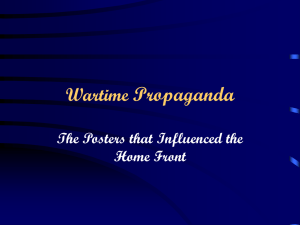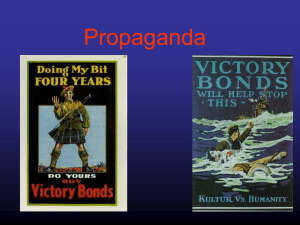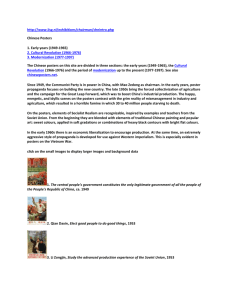File - aRT IN COMMUNISM POSTERS WEB REPORT
advertisement
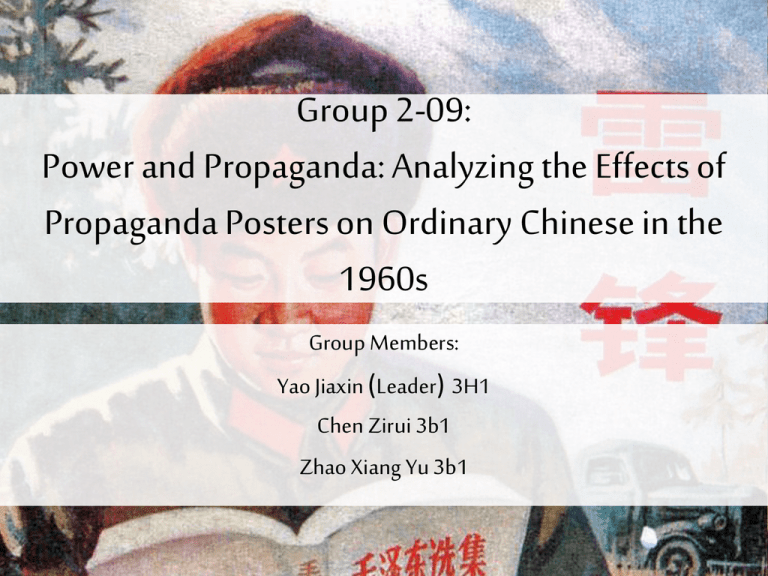
Group 2-09: Power and Propaganda: Analyzing the Effects of Propaganda Posters on Ordinary Chinese in the 1960s Group Members: Yao Jiaxin (Leader) 3H1 Chen Zirui 3b1 Zhao Xiang Yu 3b1 Agenda • • • • • • • • • Thesis statement Theories of Propaganda Scope Literature Review Research Questions Analysis Of Posters Discussion Limitation Bibliography Thesis Statement Propaganda posters are the main and most important factor in shaping identities, cultivating desired values and defining one’s role and relationship to the state under Mao’s rule. Theories of propaganda Theories of propaganda Governments use two types of institutions to establish power and control Repressive State Ideological Apparatuses State (RSAs) Apparatuses (ISAs) Police, army, Schools, prison system cinemas, et al newspapers, political Louis Althusser Yan’an Conference Chairman Mao The people cannot be forced to accept Marxist and Maoist Ideals Promote Maoist Ideologies During the Yan’an conference Schools, cinemas, newspapers, political posters Ideological State Apparatuses Scope 1958-1976 Propagand a Posters Communist China Cultural Revolution Great Leap Forward Lei Feng Chairman Mao Effects of these propaganda on the people of China Literature Review • Definition of Art • “Art is generally defined as intentionally made by their makers with a significant degree of aesthetic interest, often surpassing that of most everyday objects.It may also have a non-aesthetic purpose behind it, such as ceremonial or religious or propagandistic purpose” (Adajian, T. 2007). • “However, art can also be defined not just by its ability to express form and beauty, but also its ability to communicate concepts of morality” (Scott, A. 2002). Literature Review • “Propaganda messages during Mao’s era was filled with militant expressions such as “overthrow”, “thoroughly destroy” and “strike hard” and are often filled with militant images of war, horses, muscular workers and peasants in heroic postures.”(Murong X. ,2013) • “Many chinese posters feature heroic, cartoon like figures with political slogans to rally the masses. The images are triumphant, even if the events they depict were often disasters.” (Langfitt, F. 2012) • “ The goal of these poster was to show the Chinese people what sort of behavior was considered morally correct and how great the future of Communist China would be if everyone followed the same path towards utopia by uniting together.” (Landsberger, S. 2011) • “Mao believes that the people cannot force people to accept Marxism, and he can only persuade them” (Zedong, Mao Literature Review • Chen Xiaomei, an individual who had survived Cultural Revolution, has said “Posters remembered, talked back, and also constructed and reconstructed who I was and what was socially expected of me.” • Li Cunxin also said that he wanted to be a hero like Lei Feng and his spirit of ‘forgetting himself to help other’s was his living motto.(Cunxin, Li 2003) • “The brilliant spirit of Lei Feng and his stories influenced my perception of this world and my life choices. Should one’s achievements and fruit of labour belong to oneself or the people?(Jian Wei, Wang 2011) Research Questions • What are the trends can be drawn from the posters of Lei Feng and Mao during the Great Leap Forward and Cultural Revolution? • How has these posters impacted the lives of the people living under Mao’s rule? • Why were posters used as a tool of propaganda by Mao instead of other mediums? • What messages are conveyed as a result and how are people’s perception changed? • How did the posters help in consolidating power for Mao and the communist party? Analysis Of Posters Collection Analysis Of Posters Designer: Central Academy of Industrial Arts collective work ( 中央工艺美术学院供稿) Date published: Circa.1968 Title: Advance victoriously while following Chairman Mao's revolutionary line in literature and the arts (沿着毛主席的革命文艺路线胜利 前进) (Landsberger collection) At the height of the Mao worship, Mao appears as radiant sun, high above the masses. The dancing figures are from the revolutionary model operas developed by Analysis Of Posters Designers: Tian Yuwen (田郁文); Zhu Zhangchao (朱章超) Date published:1958, October Title:Blast furnaces rise in level ground releasing red rays everywhere (高炉平地起遍地放红光) Publisher: Renmin meishu chubanshe (人民美术出版社) Small furnaces are built everywhere to increase steel production. Useful objects, like cutlery and tools, are melted down to steel that is usually of such low quality that nothing can be done with it. Analysis Of Posters Designer: Jin Meisheng (金梅生) Publish date:1959, February Title:The vegetables are green, the cucumbers plumb, the yield is abundant (菜绿瓜肥产量多) Publisher: Shanghai renmin meishu chubanshe (上海人民美术出版社) In the years of crop failures and famine following the Great Leap Forward, this poster with its abundant food is reprinted over and over again. A first edition of this poster is already published in 1956. This particular copy is an August 1963 reprint of the 1959 edition. The total number of copies runs to over a million. Analysis Of Posters Designers: Wu Zhefu (吴哲夫); Yang Yuhua (杨玉华) Date published:1965, February Title:Uncle Lei Feng tells revolutionary stories (雷锋叔叔讲革命故事) Publisher: Shanghai renmin meishu chubanshe (上海人民美 术出版社) The children with the red scarves are Pioneers, members of the Communist youth organization. Discussion • “Posters were used as a medium of propaganda alongside with radio, speeches and education. However, posters were the most impactful method. They played a significant role in ‘attacking revisionists such as Liu Shaoqi and Deng Xiaoping’”(Ozensoy, D.C. 2015). • Posters were cheap and easily distributable. • Other methods were unfeasible • For example, speeches were unable to be delivered daily which could help influence the citizens. Education is a process that will take over 10 years to instill desirable traits into the youths, although it will pay off in the longrun. • Over time, exposure to such posters does result in indoctrination of ideologies resulting in the adoption of Discussion • Youths are more susceptible to indoctrination as they are more impressionable • It is impossible for the parents to teach values independently that are against the norms of the society • Education played a role, by helping youths adopt Maoist ideals. The education and posters worked together to bring across the values that Mao wants in his people • Characters in the posters are the most significant part of the propaganda posters, they resonated often with the individuals. • Personification of the characters results in lasting memories of the character in certain individual’s minds, leaving behind deep impressions of the values these characters portray. Discussion • However, the effect of these posters are not ever-lasting • Exposure to the outside world and sacrificing certain deep-rooted ideologies for economical gains, such as transitioning China into a more capitalist society to allow for greater growth, appears to be able to completely erode the previously deep-rooted beliefs invoked by the posters • Posters are known to change their message from time to time to reflect the historical situation and serve different purpose • Constant introduction of new posters could have been the key to maintaining or bring around political stability • Posters were therefore an essential tool in maintaining social and political stability. Case Study: Cultural Revolution • Zhang Hongbin, a Red Army Soldier, denounced his mother for being a counter-revolutionary when she burnt Mao’s picture • However, his mother knew of the repercussions. She was driven to desperation due to the prosecution of her family members prior to cultural revolution, therefore, showing that posters do not affect those whose life had been affected by CCP • Hongbin’s brother begged for his mother to not commit such “horrendous” act, but the children still denounced him because of the “political pressure”. Also, Hongbin during that time saw her mother as a “monster” and an enemy after her denouncement of Mao. • However, after Cultural Revolution, Hongbin regretted his actions deeply, saying he worse “worse than an animal” Case Study: Cultural Revolution • Another “confession” was from a red soldier called Wang Jiyu • Another red soldier in a different faction attacked him with a brick • This caused him to retaliate by hitting that soldier with his club until the club was bloodied • Later on, Wang Jiyu realised that the boy was dying in a hospital, and he was shocked at the damage he caused • He was arrested after almost 9 months despite turning himself in almost immediately due to the state of chaos China was in • The parents of the boy forgave him, thus resulting in his release • However, he no longer participated in being a Red Analysis of case study • Posters do not generate “political pressure” as it only changes mindset • Cultural Revolution appears to stem from and is maintained by herd effect • Youths often follow their friends and siblings to maintain cultural revolution by going on revolution with them • As evident from previous literature, some people are more affected by these posters and take the initiative to act as the “leader” in every state and country, causing the ripple effect among the people • The brainwashed soldiers do not appear to reflect or think of their actions as they see violence everywhere, and almost appeared to be desensitized Limitation • The full effect of these posters on the Chinese people is difficult to be determined as it is largely undocumented. There is a gap in knowledge as Chinese people than are too afraid to speak up during the Communist era but now, even though they are willing to, perceptions may have change. Authenticity of response may also be altered due to memory lapses due to time and fear of persecution. Thus, this paper is unable to give a completely accurate measure of how the art in Chinese propaganda posters have influenced the people specifically, though the general effect can be measured. Also, the analysis may lack a comparison for a fuller understanding of the effect of art on communism and what are the more popular methods dictators rely on to convey a strong message in their posters. Conclusion • Political Posters affect people differently, but causes a lot of tension • Certain people are more affected, and they take the initiative to influence others to follow communist ideologies • Cultural Revolution was Mao realising the tension that these posters have created in society, and using them to his advantage when he realised his power has diminished • However, Cultural Revolution spiraled out of control, with the Red Army fighting each other due to miscalculation of power of posters • In other times, the posters brought across positive message that shaped up the Chinese society in general Timeline Blibiography • •Adajian, T. (2007, October 23). The Definition of Art. Retrieved June 1, 2015, from http://plato.stanford.edu/entries/art-definition/ • •Alex Scott (2002 ). Tolstoy’s What is Art?. [ONLINE] from http://www.angelfire.com/md2/timewarp/tolstoy.html . • •Michael McCarty (2000). THE HISTORICAL ROOTS OF CHINESE COMMUNIST PROPAGANDA . [ONLINE] from http://www.baylor.edu/content/services/document.php ?id=19565 . • •Murong Xuecun (2013). The New face of Chinese propaganda. [ONLINE] from http://www.nytimes.com/2013/12/21/opinion/sunday/m urong-the-new-face-of-chinese-propaganda.html?_r=0 . • Nbcnewscom. (2015). Nbcnewscom. Retrieved 20 Blibiography • Mao Zedong (1957). SPEECH AT THE CHINESE COMMUNIST PARTY'S NATIONAL CONFERENCE ON PROPAGANDA WORK. [ONLINE] from https://www.marxists.org/reference/archive/mao/select ed-works/volume-5/mswv5_59.html . • •Anne-Marie Brady. Guiding Hand: The Role of the CCP Central Propaganda Department in the Current Era . [ONLINE] from https://www.westminster.ac.uk/__data/assets/pdf_file/00 15/20148/5-Brady-interim_2_.pdf . • •Frank Langfitt (2012 ). The Art Of Chinese Propaganda. [ONLINE] from http://www.npr.org/blogs/pictureshow/2012/11/16/1647 85930/the-art-of-chinese-propaganda . • Blibiography • •Andrew Bozio (2006, June 1). Interpreting Power in the Political Poster. [ONLINE] from http://www.uky.edu/Centers/Asia/SECAAS/Seras/2006/B ozio.htm • Tania branigan. (2013). The Guardian. Retrieved 3 July, 2015, from http://www.theguardian.com/world/2013/mar/27/china -cultural-revolution-sons-guilt-zhang-hongping • 解放军报(2015,June 10).陶克:人民军队为何雷锋多. Retrieved July 3,2015, from • http://theory.people.com.cn/n/2015/0610/c4053127131636.html • 王建伟(2015,March 15).雷锋精神影响了我的一生. Retrieved July 3,2015, from • http://www.wenku1.com/view/2FC7E704D04367C4.html Blibiography • 六羽毛儿(2011,January 12).雷锋精神的负面影响.Retrieved July 3rd,2015,from • http://blog.sina.com.cn/s/blog_4bb00f450100nylu.html • Chineseposters.net(2015,January 15).Lei Feng Gallery.Retrieved June 7th,2015,from • http://chineseposters.net/gallery/theme-15.php • Chineseposters.net(2015,January 15).Great Leap Forward (1956-1960).Retrieved June 7th,2015,from • http://chineseposters.net/gallery/theme-04.php • Chineseposters.net(2015,January 15).Cultural Revolution (1966-1968).Retrieved June 7th,2015,from • http://chineseposters.net/gallery/theme-07.php Blibiography • Nbcnewscom. (2015). Nbcnewscom. Retrieved 20 August, 2015, from http://behindthewall.nbcnews.com/_news/2011/09/27/7 995099-former-red-guard-breaks-silence-on-murder?lite
